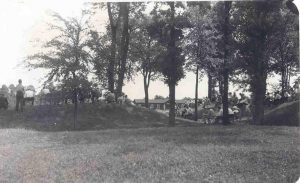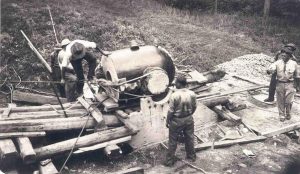The Civilian Conservation Corps at Petersburg National Battlefield
ECW welcomes back guest author Abbi Smithmyer

Petersburg National Battlefield is the site where the longest military event of the American Civil War took place. While the vast majority of the visitors who come to the battlefield seek out stories of valor, struggle, and freedom during the war, tales of restoration and the creation of the park can still be seen. The story of the Civilian Conservation Corps and the important role they played in our national parks is often overlooked, yet remnants of their work are still visible across the country today. Throughout the 1930s, the men that worked here at Petersburg developed the military park. The projects they undertook transformed portions of the battlefield through the construction of tour roads and trails for visitors. While evidence of the camp is more difficult to locate, much of what the Civilian Conservation Corps accomplished here at Petersburg National Battlefield remains and continues to influence how visitors tour the park.
After the devastating fighting of World War I, the nation was reeling under the blows of a seemingly unstoppable economic depression. The Great Depression caused worldwide devastating effects for countries both rich and poor. President Franklin D. Roosevelt’s New Deal was a far-reaching endeavor that touched the lives of nearly every American of the time. One of the first measures in an attempt to get the nation out of its economic crisis was the establishment of the Civilian Conservation Corps (CCC). Shortly after FDR’s inauguration on March 4, 1933, the CCC began.[1] Roosevelt sought to attack widespread unemployment by providing young men unskilled manual labor jobs. Roosevelt promised that his program would “be used in simple work” to “conserve our precious natural resources” which will pay dividends “to the present and future generations.”[2] Because Petersburg National Battlefield was created by an act of Congress in 1926, the majority of the park’s development took place in the 1930s as part of this New Deal initiative. Organizations like the Civilian Conservation Corps and the Public Works Administration were instrumental in the development of the battlefield. The Civilian Conservation Corps opened Camp MP-2 at Fort Stedman on Hare Hill in July 1933. The initials “MP” stood for Military Park and the companies stationed there supported park development and conservative projects across the Petersburg battlefield. The first enrollees arrived with CCC Company 1364 on July 13, 1933, having been organized at Camp Meade, Maryland. The men of Company 1364 were all white veterans of World War I. Initially, the camp consisted of approximately 50 tents and a mess hall before barracks and other buildings were eventually built which provided more permanent quarters for the enrollees.[3]
The two hundred men of Company 1364 quickly began work on the park, focusing on landscaping, roadside and land clearing, trail development, and tree removal. Petersburg’s Progress-Index described the struggles that the young men faced. “Building the park was not merely a matter of erecting monuments and tablets, of constructing fine roads, and publicity” wrote the paper, “One would hardly have guessed that great stretches of breastworks and other fortifications lay within the tangled undergrowth and dense trees that cover the greater part of the park area. To build a military park meant penetrating those woods and cleaning up.”[4]

Once brush and undergrowth were cleared, the Civilian Conservation Corps worked on the construction and upkeep of minor park roads. In July 1937, a road from Confederate Battery Nine (Tour Stop 3 on the Eastern Front) to the Hopewell Road (Modern Route 36) was open to the public. The men also worked diligently to reconstruct the historic Prince George Courthouse Road, and by 1937 it was completed and open to visitors. In March of the following year, construction began on Mortar Road, which encircled Confederate Battery Five (Tour Stop 1 on the Eastern Front). By 1939, a new entrance road to the Crater was constructed along with four and a half miles of truck trails throughout the park.[5]
Prior to the park’s creation, parts of the Eastern Front battlefield were owned by Camp Lee (now Fort Lee) and the grounds were used to train troops during the First World War before they went overseas to fight. When the National Park was established, it soon acquired land previously used by the military. Many of the training facilities and buildings still remained. These post-Civil War structures needed to be removed from the battlefield. This was another job that fell to the CCC. Many of the park roads laid out by the CCC actually had a base surface of crushed concrete that was obtained from the demolition of foundations of these World War I buildings.[6] While most of these roads are no longer traversable within the park today, early on they were an important part of the Petersburg Battlefield. Without the construction of these roadways, visitors would not have been able to tour the park as easily.
The Petersburg’s Progress-Index highlighted the importance of the Civilian Conservation Corps by stating that,
Even those people who are so short-sighted as to fail to appreciate the value of the reforestation work of the C.C.C. cannot fail to recognize the permanent worth of the work which 200 civilian workers are beginning today in the Petersburg National Military Park. Most people, we dearsay, who have not taken the trouble to familiarize themselves with this project think of it as Battery Five on the north side of the Hopewell Highway and the Fort Stedman area on the south side and have a vague idea that in time the park will include a larger territory. The truth is that in six months Petersburg will be almost surrounded by a military park of attractive appearance and…For this hastened development of the park we have the administration’s conservation program to thank.[7]
Creating these trails was vitally important, however this was not the only role the Civilian Conservation Corps played.
A lasting endeavor made by the CCC here at the Petersburg Battlefield was the conservation practices that helped preserve the natural and cultural resources of the area. Enrollees at Camp Stedman not only cleared underbrush, but they also applied seed and sod to eroded earthworks and trenches.[8] These projects transformed portions of the battlefields and continue to influence what visitors see when they tour the Petersburg Battlefield today.
When developing the Petersburg area for visitation, the National Park Service sought to provide facilities to assist visitors when they toured the battlefield. To meet the demand of increasing visitation, park interpretive facilities were constructed. Two visitor contact stations for guides were built in the City of Petersburg, with one located along Washington Street while the other was at the foot of the Appomattox River Bridge in Petersburg. Along with these facilities, three “Ranger Contact Stations” were built on the battlefield itself. These were located at Confederate Battery Five, Fort Stedman, and Fort Davis. Along with National Park Service rangers, these contact stations were also staffed by Civilian Conservation Corps guides as well as men from the Works Progress Administration, which was a New Deal program created by President Roosevelt that provided public works jobs during the Great Depression.

The historians and rangers who staffed these sites offered visitor personal services in the form of orientation to the park and informal interpretive talks. Members of the park’s historical staff developed a series of illustrated lectures for use in conducting special tours of the battlefields. These men gave free, guided tours and by 1936 it was estimated that nearly 200 persons used this service daily. By 1937, due to the increase in visitation, the number of guides was increased, bringing the total to four guides from the Works Progress Administration and six Civilian Conservation Corps guides.[9] In June 1938, the CCC completed a woodworking shop, which built tables, bookcases, and displays to be placed inside the various contact stations. Along with these inside exhibits, additional interpretive tools such as signs, maps, and markers, were located outside the contact stations to assist the park guides.
One of Petersburg National Battlefield’s major attractions, the 13-inch seacoast mortar known as the “Dictator,” had its beginnings with the Civilian Conservation Corps. While the one that sits near Battery 5 today is not the original Dictator, it is a Civil War mortar. But this mortar was not always there. In the fall of 1936, CCC enrollees cast a concrete reproduction of the Dictator and mounted it at the same site it originally occupied during the siege.[10] Through this effort, a significant step in interpreting the role of artillery at Petersburg was accomplished.
For nine years the Civilian Conservation Corps worked to transform and preserve the Petersburg battlefields. Through these efforts, along with their visitor service assistance, their efforts here at Petersburg National Battlefield were immense. After the United States entered World War II in December 1941, programs like the Civilian Conservation Corps were no longer needed. In July 1942, Camp MP-2 was closed down and an army unit from Camp Lee occupied the former buildings until 1944. In 1949, the campsite was cleared and Hare Hill was restored to its natural appearance. A number of the CCC buildings were moved and converted into utility use for the park, however only one of these is still maintained and used by the battlefield today.[11]

Very little physical evidence of CCC Camp Stedman exists on the grounds today. Nature has reclaimed the grounds where barracks, a dining hall, and other buildings once stood. In 1932, in the midst of the Great Depression, the park’s formal dedication was held. The concluding speech said,
This park is more than a monument to the past. It is a pledge to the future. The men and women who have striven so effectively for its realization obviously feel that there is going to be room in the world for happiness and relaxation. They know that the dead hand of depression does not hold us in a permanent grip…[and] when the vision of the founders of this memorial is grasped by all America, most of our troubles will be over. It is, then, as a portent of a shining future as well as a symbol of a glorious past that we dedicate this park.[12]
While the Civilian Conservation Corps would not arrive on the Petersburg battlefield for another year, the words spoken at the dedication highlight the importance of the work that these men would soon begin. Thanks to their contributions, so much of the park has been preserved and maintained. Although much of their efforts have been overshadowed and forgotten today, the work of the Civilian Conservation Corps touched the lives of nearly every American during the 1930s and their long-lasting efforts can be seen throughout Petersburg National Battlefield today.
[1] Frank C. Davis, My C.C.C. Days: Memories of the Civilian Conservation Corps (Boone, NC: Parkway Publishers, Inc., 2006), 1-2.
[2] As quoted in James J. McEntee, Now They are Men: The Story of the CCC (Washington, D.C.: National Home Library Foundation, 1940), 9-10.
[3] Lee A. Wallace Jr. and Martin R. Conway, A History of Petersburg National Battlefield (Washington, D.C.: National Park Service, 1983), 77-78.
[4] As quoted in Lee A. Wallace Jr., A History of Petersburg National Military Park Virginia (Washington, D.C.: National Park Service, 1957), 45.
[5] Wallace, A History of Petersburg National Military Park, 60-61.
[6] Ibid., 60.
[7] Wallace and Conway, A History of Petersburg National Battlefield, 78.
[8] Ibid., 88.
[9] Wallace, 66-67.
[10] Wallace and Conway, 110.
[11] Wallace, 92.
[12] Wallace and Conway, 80.